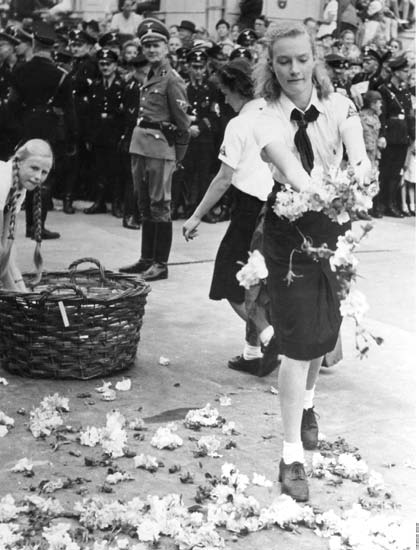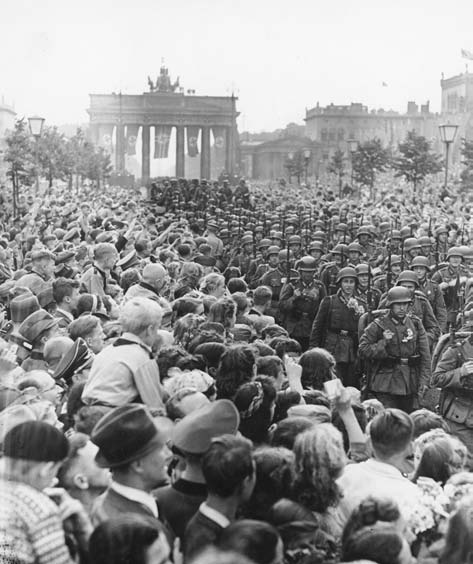Berlin at War (25 page)
Authors: Roger Moorhouse

the human dimension is almost completely absent. As Speer recalled,
Hitler had absolutely no interest in the social aspects of the planning
that he oversaw; his passion was for the buildings themselves, rather
than for the human beings who might one day inhabit them.32 Indeed,
it has been plausibly suggested that the plans for Berlin’s reconstruction
betrayed Hitler’s megalomaniacal desire to reduce cities and even indi-
viduals to the status of mere playthings.33 When one recalls the images
of Hitler stooped like some malevolent deity over his architectural
models in the Reich Chancellery, this interpretation becomes instantly
and chillingly persuasive.
However, for all its overweening ambition, its megalomania and its
misanthropy, the rebuilding of Berlin was
not
a Nazi pipe dream. As
Speer recalled in his post-war diary:
brutality made stone
111
It seemed to all of us that with every passing month we were almost
effortlessly drawing nearer to the reason for the arches of triumph and
the avenues of glory. The Great Hall and the Berlin Palace of the Führer
suddenly acquired a real background: the victories in Poland and
Norway, the conquest of France. In the crypt of the Soldiers’ Hall innu-
merable places were reserved for the sarcophagi of the commanders
of these campaigns.34
From the perspective of 1941, Germania was very real indeed. Hitler
himself was obsessed with the project. When he learned that Stalin was
unveiling plans for remodelling Moscow, he was so outraged that it was
on his mind on the day his armies invaded the USSR in the summer of
1941. In spite of the fact that his soldiers had just embarked on the largest
military campaign in history, a struggle that would make or break the
Third Reich, Hitler, it seems, was musing once again on architecture.
‘This’, he said to Speer that day, ‘will be the end of
their
building for good and all.’35
Indeed, by 1941, the translation from theory to reality was already
well under way. The first part of the realisation was the demolition of
those buildings that, by dint of their insufficient grandeur or the acci-
dent of their location, were slated to be destroyed. This process had
begun in 1938, when labourers had started clearing the area of the Spree
bend – the projected location of the Great Hall – as well as the streets
surrounding the planned Circus near Potsdamer Platz and the proposed
South Railway Station in Tempelhof. Already by the end of that year,
some seven thousand properties had been demolished. A further 62,000
demolitions were considered necessary.36
Initially, the affected buildings were painstakingly dismantled, with
each one requiring an average of sixty days of intensive and often
specialised labour in order to preserve building materials that could be
used elsewhere and to protect remaining buildings in close proximity.37
After the outbreak of the war, however, Speer began to despair at the
slow progress. In May 1940, he advocated that dynamite should be used
so that prisoners of war and concentration camp labour could be more
effectively utilised in clearing the debris.38
Indeed, in time, the methods advocated – or tolerated – by Speer
and his staff would become more brutal still. A cartoon drawn by one
of Speer’s department chiefs showed the capital’s suburbs being blasted
112
berlin at war
away with an enormous cannon.39 It was not really a joke. On 26 April
1941, Rudolf Wolters, one of Speer’s lieutenants, wrote that the British
bombing raid of the previous night, which had hit the area around
Potsdamer Platz, close to the site of the proposed Circus, had ‘achieved
valuable preparatory work for the purposes of the rebuilding of
Berlin’.40 That same month an internal memo noted that over 53,000
properties had already been demolished in the capital – it amounted
to only 3.6 per cent of the total.41
Alongside the demolition, construction was also under way. Beneath
the Tiergarten, for instance, a network of road tunnels was built, which
were intended to ease traffic flow around the intersection of the two
main boulevards, just west of the Brandenburg Gate. Other sites were
rather more obvious. In the area of the planned Circus, the first new
block had already risen from the rubble. The
Haus des Fremdenverkehrs
,
or ‘Foreign Travel Office’, occupied the site where Hitler had laid the
first foundation stone for the reconstruction of Berlin in the summer
of 1938.42 Completed at least in its essentials by the outbreak of war,
it soon dominated the local landscape. Its one concave, arcaded frontage
faced the wasteland that was foreseen as the Circus, and was comple-
mented by two wings extending for around 100 metres along the side
roads. Imposing in both in design and execution, it was intended, quite
explicitly, to impress and intimidate foreign travellers arriving to register
in the German capital.
All of this came at a human cost. Thousands of POWs and forced
labourers were housed in often substandard conditions and made to
work in all weathers. Despite his later protestations of innocence,
Speer was never shy of using POWs as labour. Indeed, in November
1941, after the opening successes of the war against the Soviet Union,
he petitioned Hitler with a request for some 30,000 Soviet POWs
specifically for use in the construction of the ‘new Berlin’. Hitler
acceded to the request, thereby bringing the total workforce over-
seen by Speer’s staff to around 130,000.43
In addition, most of the stone and bricks that were prepared for
the project came from the network of concentration camps dotted
about Nazi Germany. It is little appreciated that many of the most
infamous concentration camps of the Nazi era – Dachau, Gross Rosen
and Buchenwald among them – were established close to quarries.
The camp at Mauthausen, for instance, was set up alongside the granite


Adolf Hitler’s fiftieth birthday parade, 20 April 1939:
‘It was a feast for the eyes and the applause never seemed to end.’
‘We have now been returning fire since 5.45 a.m.’: Hitler announces the invasion of Poland to the Reichstag inside the Kroll Opera House, 1 September 1939.



Whitewashing the kerbstones
in preparation for the blackout.
Another novelty from the early days
of the war: a sign directs Berliners to
a public air-raid shelter.
Camouflage netting close to the Brandenburg
Gate. ‘We absolutely must do more to keep
morale high’, Goebbels wrote in his diary.
‘The continual air-raid alerts are making the
people nervous. We must be careful.’



